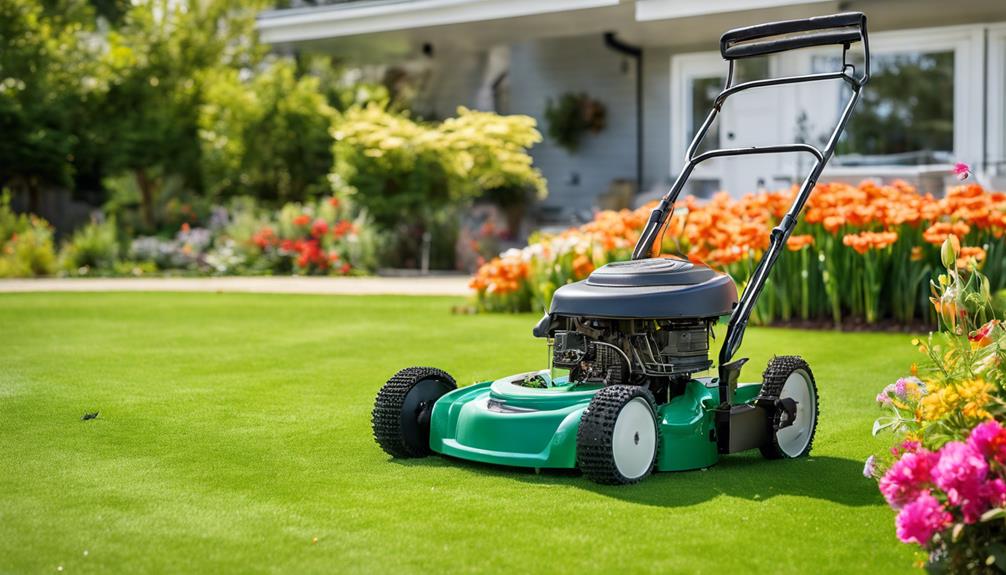
Top Lawn Fertilization Services for Vibrant Grass
6 September 2024
Discover Affordable Landscaping and Lawn Care Packages
7 September 2024The top five lawn aeration and dethatching services concentrate on revitalising turf and enhancing soil health.
These services effectively reduce compaction and promote nutrient absorption. Aeration facilitates deeper root development, while dethatching removes excess organic material that hinders growth.
Choosing skilled professionals ensures the use of appropriate equipment tailored to your lawn's specific needs. Furthermore, these services contribute to increased resilience against environmental stressors.
Opting for experts like TKL Birmingham Gardener guarantees personalised solutions and sustainable practices for your lawn.
To uncover effective techniques and recommendations for ideal lawn care, explore further into aeration and dethatching practices.
Service Importance and Benefits
Lawn aeration and dethatching services play a vital role in enhancing soil health by alleviating compaction and improving nutrient absorption.
These practices promote robust grass growth by ensuring that air, water, and essential nutrients reach the root system effectively.
As a result, maintaining a healthy lawn becomes more achievable, leading to a vibrant and resilient landscape.
Enhances Soil Health
Healthy soil is fundamental for vibrant, thriving grass and plant life, and professional aeration and dethatching services play a significant role in enhancing its quality.
These services effectively alleviate soil compaction, allowing air, water, and nutrients to penetrate deeper into the root zone. By removing excessive thatch, they facilitate microbial activity, which is critical for nutrient cycling and improving soil structure.
Enhanced soil health fosters a diverse ecosystem, promoting beneficial organisms that contribute to nutrient availability and disease resistance.
Furthermore, balanced soil pH levels and improved drainage patterns are achieved, leading to robust and resilient turf.
Ultimately, investing in aeration and dethatching is not merely a maintenance task; it is a strategic enhancement of the soil's fundamental attributes, essential for sustainable lawn care.
Promotes Grass Growth
How can lawn aeration and dethatching services greatly contribute to lush grass growth?
These essential services facilitate improved air circulation, nutrient absorption, and moisture retention within the soil. Aeration alleviates soil compaction by creating small perforations, allowing roots to penetrate deeper and access vital resources.
Meanwhile, dethatching removes excessive organic debris, which can hinder grass from receiving adequate sunlight and nutrients. By optimising the growing conditions, these services promote robust root development and enhance overall turf vigour.
Consequently, a well-aerated and dethatched lawn exhibits increased resilience against pests, diseases, and environmental stressors. Investing in these services not only fosters greener, denser grass but also establishes a sustainable foundation for long-term lawn health and beauty.
Soil Health and Aeration
Soil health is paramount for maintaining a vibrant lawn, and aeration plays a key role in enhancing it.
By improving root oxygenation, lawns can better absorb essential nutrients, which in turn fosters robust plant growth.
Furthermore, aeration promotes improved soil microbial activity, creating a thriving ecosystem that supports comprehensive lawn vitality.
Root Oxygenation Improvement
Effective root oxygenation is crucial for maintaining ideal soil health and promoting robust lawn growth. When roots receive sufficient oxygen, they can effectively metabolise nutrients, improving overall plant vigour.
Aeration services facilitate this process, ensuring that oxygen penetrates deeper into the soil profile. Key benefits of improved root oxygenation include:
- Enhanced root development and strength
- Increased microbial activity, fostering a healthy ecosystem
- Reduction of soil compaction, leading to better aeration
- Greater resilience against environmental stressors
- Promotion of balanced moisture levels within the soil
Investing in aeration and dethatching services can significantly enhance your lawn's health, ensuring a thriving, lush landscape that is the envy of the neighbourhood.
Proper root oxygenation is a cornerstone of exceptional lawn care.
Enhanced Nutrient Absorption
Improved nutrient absorption is one of the primary benefits of lawn aeration, as it allows essential nutrients to penetrate deeper into the root zone.
By alleviating soil compaction, aeration not only facilitates access to nutrients but also enhances the overall health of the lawn.
Key advantages of improved nutrient absorption through aeration include:
- Deeper root development: Encourages roots to grow deeper, accessing more nutrients and moisture.
- Balanced nutrient distribution: Promotes even nutrient distribution across the lawn.
- Reduced runoff: Minimises nutrient loss through surface runoff, optimising resource usage.
- Improved soil structure: Increases soil porosity, enabling better water infiltration and retention.
- Sustained growth: Fosters a more resilient lawn capable of withstanding environmental stressors.
Investing in aeration therefore greatly boosts the health and vigour of your lawn.
Improved Soil Microbial Activity
A healthy lawn relies on a diverse community of microorganisms that play a crucial role in nutrient cycling and soil fertility. Proper lawn aeration improves soil structure, allowing for better gas exchange and water infiltration.
This process creates a conducive environment for microbial activity, which is essential for soil health.
Key benefits of improved soil microbial activity include:
- Enhanced Nutrient Cycling: Microbes decompose organic matter, releasing vital nutrients.
- Soil Structure Improvement: Microbial activity promotes the formation of soil aggregates, enhancing aeration.
- Disease Suppression: Beneficial microbes can outcompete harmful pathogens.
- Water Retention: Microbial processes improve the soil's ability to retain moisture.
- Increased Biodiversity: A thriving microbial community supports a healthy ecosystem.
Investing in aeration fosters a robust microbial landscape, ensuring long-term lawn health.
Selecting the Right Equipment
Selecting the right equipment for lawn aeration and dethatching begins with a thorough assessment of the lawn's condition.
Timing is essential to achieve the best results, as soil moisture and grass growth influence the effectiveness of the process.
Furthermore, understanding the different core aeration methods available will help ensure that the chosen equipment meets the specific needs of your lawn.
Assessing Lawn Condition First
Before commencing lawn aeration or dethatching, it is essential to thoroughly assess the condition of your lawn. This evaluation ensures that the appropriate techniques and equipment are utilised, optimising the results of your efforts.
Key factors to take into consideration include:
- Soil Compaction: Examine areas of heavy foot traffic.
- Thatch Thickness: Measure the organic layer between grass and soil.
- Grass Type: Identify the species to tailor care strategies effectively.
- Moisture Levels: Assess soil moisture to determine readiness for aeration or dethatching.
- Overall Health: Inspect for pests, diseases, or nutrient deficiencies.
Timing for Optimal Results
Understanding the timing for lawn aeration and dethatching is crucial to achieving ideal results, and selecting the appropriate equipment plays a significant role in this process.
Optimal performance hinges on choosing tools that align with your lawn's needs and seasonal conditions. Consider the following equipment options:
- Core Aerator: Ideal for compacted soils.
- Spike Aerator: Best for less compacted lawns.
- Dethatching Rake: Effective for manual dethatching.
- Power Dethatcher: Suitable for extensive thatch removal.
- Tow-Behind Dethatcher: Efficient for large areas when attached to a mower.
Each piece of equipment serves a unique purpose; understanding when to deploy them enhances the health and vitality of your lawn, ensuring a lush, green landscape.
Core Aeration Methods
Core aeration is a fundamental practice for maintaining a healthy lawn, and choosing the right equipment is essential to its effectiveness. The proper tools can considerably improve aeration results, allowing for ideal soil penetration and enhanced nutrient absorption.
When selecting equipment, consider the following:
- Type of Aerator: Decide between spike, plug, or liquid aerators based on the needs of your lawn.
- Tine Length: Longer tines penetrate deeper, promoting better aeration.
- Weight and Size: Heavier aerators provide more pressure for effective soil disruption.
- Power Source: Choose between manual, electric, or petrol-powered options for convenience and efficiency.
- Ease of Use: Assess user-friendliness to ensure effective operation and maintenance.
Investing in the right equipment will yield long-term benefits for your lawn's health and aesthetics.
Increased Lawn Resilience
Lawn health benefits significantly from aeration and dethatching, leading to increased resilience against environmental stressors. These services enhance the root system, allowing for improved nutrient uptake and water retention, which are vital for enduring drought or heavy rainfall. Furthermore, they alleviate soil compaction, promoting better oxygen circulation.
| Benefit | Description | Impact on Resilience |
|---|---|---|
| Nutrient Uptake | Facilitates absorption of essential nutrients | Strengthens root health |
| Soil Aeration | Reduces compaction for improved air flow | Boosts drought resistance |
| Thatch Removal | Prevents the harbouring of diseases and pests | Improves lawn vigour |
| Moisture Retention | Increases the soil's ability to retain water | Supports growth during dry spells |
| Root Development | Encourages deeper root systems | Enhances stability and health |
Lawn Restoration Techniques
Lawn restoration techniques are essential for revitalising turf following aeration.
Key practices include the strategic application of fertilisers to enhance soil nutrients, post-aeration topdressing to improve soil structure, and overseeding to encourage a thicker, healthier lawn.
Implementing these methods effectively can result in a lush and resilient garden.
Fertilizer Application After Aeration
Fertiliser application plays a crucial role in the restoration of healthy turf following aeration. After aerating, the soil becomes more receptive to nutrients, making this an opportune time to implement a targeted fertilisation strategy.
Employing the right type of fertiliser can greatly improve the recovery process and promote vigorous growth. Consider the following aspects when applying fertiliser post-aeration:
- Nutrient Composition: Choose fertilisers rich in nitrogen, phosphorus, and potassium.
- Application Timing: Fertilise within 24-48 hours post-aeration for ideal absorption.
- Soil Testing: Conduct soil tests to tailor nutrient applications to specific needs.
- Watering Schedule: Follow up with adequate watering to activate the fertiliser.
- Follow-Up Applications: Plan for subsequent fertilisations to maintain nutrient levels.
Implementing these practices will ensure a lush, resilient lawn.
Post-Aeration Topdressing Application
A successful post-aeration strategy often includes a well-planned topdressing application, which can considerably improve soil quality and promote healthier turf.
Topdressing involves applying a layer of organic material, such as compost or soil, to the surface of the lawn. This technique enhances soil structure, moisture retention, and nutrient availability.
Key benefits of topdressing post-aeration include:
- Improved Soil Aeration: Boosts air exchange within the soil profile.
- Enhanced Nutrient Delivery: Provides crucial nutrients to the turf.
- Reduction of Compaction: Alleviates soil compaction for better root growth.
- Increased Microbial Activity: Stimulates beneficial microbial populations.
- Surface Leveling: Helps to smooth out uneven lawn areas.
Consistently implementing topdressing after aeration will foster a lush, resilient lawn.
Seed Overseeding for Thickening
Following a successful topdressing application, seed overseeding plays a vital role in enhancing lawn density and promoting overall health. This technique involves strategically dispersing high-quality seed over the existing turf, fostering a thicker and more resilient lawn.
Proper overseeding can help fill bare patches, combat weeds, and improve the general aesthetic appeal of your landscape.
Key benefits of seed overseeding include:
- Improved turf density, boosting visual appeal
- Increased resilience against pests and diseases
- Better drought tolerance and water retention
- Promotion of a healthier root system
- Reduction of soil compaction through better root structure
Implementing overseeding in conjunction with aeration and dethatching cultivates a robust lawn, ensuring longevity and vibrancy for years to come.
Frequent Lawn Compaction Issues
Frequent lawn compaction can severely hinder grass growth and overall lawn health.
Addressing this issue involves exploring treatment options for compacted soil, adjusting soil pH, and incorporating soil amendments to alleviate compaction.
Understanding these strategies is crucial for maintaining a thriving and resilient lawn.
Compacted Soil Treatment Options
Compacted soil presents significant challenges for lawn health, often resulting in poor drainage and restricted root growth.
Addressing soil compaction is essential for rejuvenating your lawn. Various treatment options can alleviate compaction and foster a flourishing landscape.
- Core Aeration: Mechanically removes plugs of soil, allowing air, water, and nutrients to penetrate more deeply.
- Topdressing: Applying a thin layer of compost or soil to enhance soil structure and increase microbial activity.
- Soil Amendments: Incorporating organic matter or gypsum to improve soil texture and drainage.
- Regular Lawn Maintenance: Implementing a consistent mowing and watering schedule to prevent future compaction.
- Strategic Planting: Selecting deep-rooted plants that naturally aerate the soil over time.
Utilising these techniques will significantly enhance lawn health.
Soil Ph Adjustment Techniques
Addressing soil compaction often reveals underlying issues related to soil pH, which can further hinder lawn health. An ideal pH level is crucial for nutrient availability and microbial activity.
To effectively adjust soil pH, consider the following techniques:
- Soil Testing: Conduct a thorough analysis to determine current pH and nutrient levels.
- Lime Application: Utilise agricultural lime to raise pH in acidic soils, enhancing nutrient uptake.
- Sulphur Use: Apply elemental sulphur for lowering pH in alkaline soils, promoting a balanced environment.
- Organic Matter: Incorporate compost or well-rotted manure to naturally buffer pH fluctuations.
- Regular Monitoring: Establish a routine for testing and adjusting soil pH to maintain ideal conditions for lawn growth.
Employing these techniques can greatly improve lawn health and resilience.
Soil Amendments for Compaction Relief
How can soil amendments effectively alleviate the persistent issue of lawn compaction?
Implementing specific soil amendments can considerably improve soil structure and promote healthier root growth, thereby reducing compaction. These amendments work by enhancing aeration, water infiltration, and nutrient availability.
Key options include:
- Organic Matter: Incorporating compost or well-rotted manure improves soil texture.
- Gypsum: Reduces compaction in clay soils and promotes drainage without altering pH.
- Sand: When mixed with heavy soils, it enhances aeration and mitigates compaction.
- Biochar: Improves soil fertility and increases microbial activity, aiding in structure.
- Worm Castings: Elevates soil health and microbial diversity, improving overall resilience.
Utilising these amendments strategically can lead to long-term relief from lawn compaction issues.
Why Choose TKL Birmingham Gardener
Choosing the right gardening service can greatly impact the health and appearance of your lawn, making expertise and reliability paramount.
TKL Birmingham Gardener stands out as a premier choice for lawn aeration and dethatching. Their team of experienced professionals employs advanced techniques and state-of-the-art equipment to guarantee optimal soil penetration and effective thatch removal.
This commitment to quality fosters robust root systems and encourages healthy grass growth. In addition, TKL's personalised approach means tailored solutions for each unique lawn, addressing specific needs and conditions.
With a focus on sustainable practices, they not only enhance the aesthetic appeal of your outdoor space but also contribute to long-term ecological health.
Trust TKL Birmingham Gardener to elevate your lawn to its fullest potential.
Common Aeration Misconceptions
Lawn aeration, despite its significance, is often surrounded by several misconceptions that can lead to confusion among homeowners.
One prevalent myth is that aeration is only necessary for heavily compacted soils, whereas, in reality, all lawns benefit from periodic aeration to improve root growth and nutrient absorption.
Another misconception is that aeration creates unsightly holes; however, these holes are temporary and promote a healthier lawn by allowing air, water, and nutrients to penetrate deeper into the soil.
Furthermore, some believe that aeration can be carried out at any time, when in truth, the best timing coincides with the growing season for the specific type of grass.
Understanding these misconceptions is crucial for achieving a lush, vibrant lawn.
Final Thoughts on Aeration
Understanding the misconceptions surrounding lawn aeration is the initial step towards appreciating its significance in maintaining a healthy garden.
Aeration boosts root growth, improves nutrient absorption, and fosters a thriving ecosystem in your soil. By recognising its value, homeowners can make informed decisions that promote long-term lawn health.
Consider the following key benefits of aeration:
- Improved Water Infiltration: Reduces runoff and allows water to penetrate more deeply.
- Augmented Nutrient Uptake: Facilitates better absorption of fertilisers and organic matter.
- Increased Soil Aeration: Promotes a balanced air-to-soil ratio for root respiration.
- Reduced Soil Compaction: Alleviates pressure on roots, encouraging robust growth.
- Revitalised Lawn Health: Supports a lush, vibrant, and resilient lawn ecosystem.
Investing in aeration is crucial for any serious lawn care regimen.




